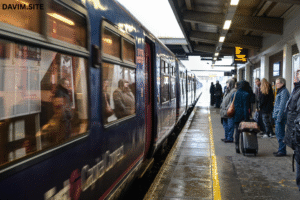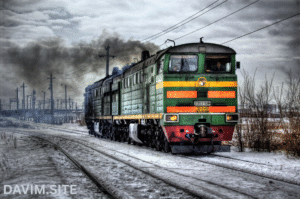
The railway sector is not an exception to invention in the era of digital revolution. The Rail Operating Centre (ROC), a vital part of the modernizing of rail network administration, sits at the core of this change. Whether you work in the infrastructure, transportation, or railway sectors—or are just a curious visitor—you may have heard of ROCs, but do you know why they are important and how they operate?
This extensive book covers what a Rail Operating Centre is, how it operates, its strategic advantages, and its part in future-proofing railway operations all throughout the UK and beyond.
What is a Rail Operating Centre (ROC)?
Oversaw train traffic, signaling systems, and operational communication throughout specified railway zones from a centralized control center known as a train Operating Center (ROC). Consider it as train operations’ “nerve center.” Contemporary railway networks are increasingly under control from ROCs fitted with contemporary digital technology and real-time data, rather than from individual sections of track with local signal boxes.
To guarantee safe and effective rail transportation across areas, each ROC combines complicated signaling systems, train schedule data, and live operational input. By offering a combined perspective of the network, they also help operational managers, signalers, and traffic controllers.
The Evolution of Train Signaling: From Signal Boxes to ROCs
Before ROCs, the UK rail system relied heavily on manual signal boxes. Signalmen would operate levers to change signals and switches, coordinating the safe passage of trains through their jurisdiction. While this system worked for over a century, it had limitations:
-
Decentralized control
-
Slow communication during disruptions
-
Human error risk
-
Inability to scale efficiently
The transition to Rail Operating Centres marks a major leap toward automation, digital oversight, and operational resilience. It reflects the broader strategy of consolidating train control into fewer, more technologically advanced centers.
How Does a Rail Operating Centre Work?
A ROC uses a combination of real-time data, automated signaling, train movement tracking, and communication systems to manage train traffic. Key technologies used include:
-
Rail Traffic Management Systems (TMS)
-
Automatic Route Setting (ARS)
-
SCADA Systems (Supervisory Control and Data Acquisition)
-
Digital interlockings
-
Live CCTV and real-time GPS feeds
Every ROC oversees a vast geographic area with teams of signallers and controllers working on giant digital displays showing train whereabouts, track condition, and schedule performance.
For smooth cross-regional mobility, the York ROC—one of the biggest in the UK—coordinates with other ROCs and manages paths spanning hundreds of kilometers.
Key Functions of a Rail Operating Centre
Understanding what a ROC does on a daily basis reveals its vital role in modern rail management:
1. Train Traffic Control
ROCs monitor and manage train movements in real-time. They ensure that trains operate on schedule, adjust for delays, and re-route services during disruptions.
2. Signaling and Safety
Automated digital signals allow for quicker, more reliable train control. ROCs oversee all signaling activity to reduce the chance of human error.
3. Disruption Management
Whether it’s a technical failure, extreme weather, or passenger emergencies, ROCs coordinate the response, update systems, and inform the public in real-time.
4. Passenger Information Systems
ROCs provide real-time updates to platforms, apps, and customer displays about train schedules, delays, or cancellations.
5. Maintenance Scheduling
By tracking rail wear, signal status, and performance anomalies, ROCs help schedule preventive maintenance before failures occur.
Benefits of Rail Operating Centres
The shift from traditional signal boxes to ROCs has delivered significant benefits:
✅ Centralized Control
ROC teams can oversee vast sections of the rail network from a single location, improving coordination and decision-making.
✅ Improved Safety
Digital interlocking and automatic route setting reduce the possibility of signaling errors and train collisions.
✅ Operational Efficiency
Automated systems reduce the workload on human operators and ensure smoother, faster decision-making during high-traffic or crisis situations.
✅ Scalability
As passenger numbers grow, ROCs can scale up to meet increased demand without major infrastructure overhauls.
✅ Better Communication
With real-time data sharing between ROCs, operators, and passenger services, delays and issues are addressed more proactively.
Major ROCs in the UK
Network Rail has committed to consolidating more than 800 signal boxes into just 12 Rail Operating Centres across the UK. Here are a few notable ones:
📍 York ROC
One of the largest in Europe, controlling much of the East Coast Main Line.
📍 Didcot ROC
Covers much of the Great Western Main Line and parts of Wales.
📍 Manchester ROC
Manages rail operations across the northwest, including one of the UK’s busiest corridors.
📍 Rugby ROC
Plays a crucial role in the West Coast Main Line.
Each ROC is built with long-term expansion in mind, with space and infrastructure to handle increased train traffic and future technologies.
Rail Operating Centres and Digital Railway Strategy
The UK’s Digital Railway Strategy hinges on implementing smarter, faster, and safer technology across the network. ROCs play a vital role in enabling this transformation:
-
Integration with ERTMS (European Rail Traffic Management System)
-
Capacity optimization using AI and data analytics
-
Reducing delays and dwell times
-
Improving passenger experience
With these systems in place, the Digital Railway aims to increase track capacity without needing more physical rail lines—a more sustainable approach to rail development.
Challenges Facing ROCs
Despite the clear advantages, ROCs are not without challenges:
-
High implementation costs: Building and staffing ROCs require significant upfront investment.
-
Cybersecurity concerns: Centralized systems are more vulnerable to digital threats.
-
Staffing and skill gaps: Digital systems require new training and technical expertise.
-
Public and stakeholder acceptance: Transitioning from a heritage-based system to a tech-heavy one can cause resistance among rail workers and local communities.
However, as technology matures and the benefits become more evident, these challenges are being actively addressed.
Future of Rail Operating Centres
Looking ahead, ROCs are expected to become even more integrated with AI, cloud computing, and predictive analytics. Future possibilities include:
-
AI-driven decision support systems
-
Real-time crowd and load monitoring
-
Digital twins of the rail network for simulation and training
-
Remote operations using cloud platforms
As more data is collected and analyzed, ROCs will likely serve as decision-making centers not just for train movement, but also for energy management, weather prediction, and passenger behavior insights.
Conclusion
More than just a contemporary substitute for the signal box, the Rail Operating Centre (ROC) represents the digital heart of the future rail sector. ROCs are changing the way trains run all throughout the UK by centralizing control, boosting safety, increasing efficiency, and including smart technology.
For travellers, this translates into quicker updates, more consistent travel and better experiences. It implies a safer, more scalable, data-driven railway for operators and infrastructure suppliers.
Rail Operating Centres will become more important as the rail sector develops to guarantee the railway stays suitable for the twenty-first century and beyond.
Keywords Used (for SEO optimization):
-
Rail Operating Centre
-
Rail Operating Centres UK
-
What is a rail operating centre
-
ROC train control
-
Railway digital control systems
-
Train signaling UK
-
Digital railway strategy
-
Network Rail ROC
-
Train disruption management
-
Future of rail transport UK
